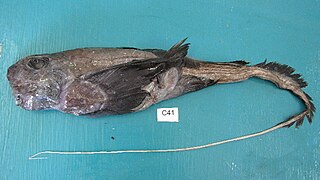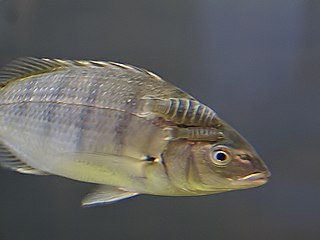
The Cape vulture, also known as Cape griffon and Kolbe's vulture, is an Old World vulture in the family Accipitridae. It is endemic to southern Africa, and lives mainly in South Africa, Lesotho, Botswana, and in some parts of northern Namibia. It nests on cliffs and lays one egg per year. In 2015, it had been classified as Endangered on the IUCN Red List, but was down-listed to Vulnerable in 2021 as some populations increased and have been stable since about 2016.

The broadnose sevengill shark is the only extant member of the genus Notorynchus, in the family Hexanchidae. It is recognizable because of its seven gill slits, while most shark species have five gill slits, with the exception of the members of the order Hexanchiformes and the sixgill sawshark. This shark has a large, thick body, with a broad head and blunt snout. The top jaw has jagged, cusped teeth and the bottom jaw has comb-shaped teeth. Its single dorsal fin is set far back along the spine towards the caudal fin, and is behind the pelvic fins. In this shark the upper caudal fin is much longer than the lower, and is slightly notched near the tip. Like many sharks, this sevengill is counter-shaded. Its dorsal surface is silver-gray to brown in order to blend with the dark water and substrate when viewed from above. In counter to this, its ventral surface is very pale, blending with the sunlit water when viewed from below. The body and fins are covered in a scattering of small black & white spots. In juveniles, their fins often have white margins.

The school shark is a houndshark of the family Triakidae, and the only member of the genus Galeorhinus. Common names also include tope, tope shark, snapper shark, and soupfin shark. It is found worldwide in temperate seas at depths down to about 800 m (2,600 ft). It can grow to nearly 2 m long. It feeds both in midwater and near the seabed, and its reproduction is ovoviviparous. This shark is caught in fisheries for its flesh, its fins, and its liver, which has a very high vitamin A content. The IUCN has classified this species as critically endangered in its Red List of Threatened Species.

The leafscale gulper shark is a dogfish of the family Centrophoridae. C. squamosus is reported to have a lifespan of approximately 70 years, based on otolith ring counts. It was the first described species in the genus Centrophorus, which now contains 13 species.

The brown shyshark or plain happy is a species of catshark, part of the family Scyliorhinidae. It is endemic to the shallow, coastal waters of South Africa from west of Cape Agulhas to KwaZulu-Natal. This benthic species is usually found over sandy or rocky bottoms. Measuring up to 73 cm (29 in) long, the brown shyshark is stoutly built, with a broad, flattened head and rounded snout. Unlike other shysharks, the brown shyshark has a plain brown color, though some individuals have faint "saddle" markings or light or dark spots. When threatened, this shark curls into a circle with its tail over its eyes, which is the origin of the name "shyshark". It feeds on bony fishes and lobsters, and is oviparous with females laying pairs of egg capsules. The International Union for Conservation of Nature (IUCN) has assessed this harmless species as Vulnerable. It is of no commercial or recreational interest, but its limited distribution makes its entire population vulnerable to increases in fishing pressure or habitat degradation.

The yellowspotted catshark is a rare catshark of the family Scyliorhinidae. It is found in the southeast Atlantic, from Lüderitz, Namibia to central Natal, South Africa, between latitudes 0° and 37° S. It can grow up to a length of about 1.22 metres. The reproduction of this catshark is oviparous.

The African sawtail catshark is a species of catshark, part of the family Scyliorhinidae. Demersal in nature, it is found at depths of 160–720 m (520–2,360 ft) off the western African coast from Morocco to South Africa. This slender species has a rather long, pointed snout, a series of dark saddles along the back and tail, and a prominent crest of enlarged dermal denticles along the upper edge of the caudal fin. Its maximum known length is 46 cm (18 in).

Callorhinchus, the plough-nosed chimaeras or elephantfish, are the only living genus in the family Callorhinchidae. A few extinct genera only known from fossil remains are recognized. Callorhinchus spp. are similar in form and habits to other chimaeras, but are distinguished by the presence of an elongated, flexible, fleshy snout, with a vague resemblance to a ploughshare. They are only found in the oceans of the Southern Hemisphere along the ocean bottom on muddy and sandy substrates. They filter feed, with small shellfish making up the bulk of their diet. The plough-nosed chimaera lays eggs on the ocean floor that hatch at around 8 months. They are currently not a target of conservation efforts; however, they may be susceptible to overfishing and trawling.
The carpenter's chimaera, also known as the giant chimaera or the giant purple chimaera, is a species of fish in the family Chimaeridae.

The African chimaera is a species of fish in the family Chimaeridae found near Kenya, Mozambique, Namibia, and South Africa. Its natural habitat is deep-waters up to the depth of 750 m Eight species of chimaera are found in the southern African region, representing the three families and all six genera.

Ogilby's ghostshark, also known as the whitefish, is a species of chimaera, native to the waters of Australia and southern Indonesia. It lives near the ocean floor on the continental shelf and continental slope 120–350 m (390–1,150 ft) deep. It reaches a maximum size of 85.0 cm (33.5 in). Reproduction is oviparous and eggs are encased in horny shells. It reaches maturity between 64–70 cm (25–28 in) in length. It is listed as a near-threatened species by the International Union for Conservation of Nature (IUCN) due to steep declines in population in areas affected by trawling.

The pointy-nosed blue chimaera, also known as the pointy-nosed blue ratfish, Ray Troll's chimaera or abyssal ghostshark, is a species of deep-sea fish in the family Chimaeridae.

Chimaera monstrosa, also known as the rabbit fish or rat fish, is a northeast Atlantic and Mediterranean species of cartilaginous fish in the family Chimaeridae. The rabbit fish is known for its characteristically large head and small, tapering body. With large eyes, nostrils, and tooth plates, the head gives them a rabbit-like appearance, hence the nickname “Rabbit fish”. They can grow to 1.5 metres (5 ft) and live for up to 30 years.

The large-eyed rabbitfish is a species of fish in the family Chimaeridae. It is found in several areas of the Atlantic Ocean and within the Mediterranean Sea.

The west coast seabream or west coast steenbras is a species of marine fish in the family Sparidae. It is found in very shallow water off the coasts of to Angola, Namibia and South Africa. The International Union for Conservation of Nature lists its conservation status as being "near threatened".
Chimaera bahamaensis, commonly known as the Bahamas ghost shark, is a species of fish in the family Chimaeridae. It is found in North Atlantic Ocean around the Bahamas, specifically it has been found east of Andros Island. Chimaera bahamaensis is known to inhabit marine waters from a depth range of 1,483 metres (4,865 ft) – 1,506 metres (4,941 ft). It is one of the most recently described members of the genus Chimaera and to date only a single specimen has been found.
The southern chimaera is a chimaera species in the family Chimaeridae. It lives in Australia, usually in marine waters 780 to 1095 meters deep. It can grow to a maximum length of at least 100 centimeters, and is sometimes confused with Chimaera obscura, a similar species in its genus.
The longspine chimaera is a chimaera species in the family Chimaeridae. It is found off of the eastern and western coasts of Australia, and lives in tropical and temperate waters 435–1,300 meters deep. Males and females grow to a maximum total length of 93.9 and 103.4 centimeters, respectively, and are brown in color.
The shortspine chimaera, also commonly known as the short spine chimaera, is a chimaera species in the family Chimaeridae, which lives off of the east coast of Australia.

The black ghostshark, also known as the black chimaera, is a chimaera species within the family Chimaeridae. The species lives off the coasts of Australia and New Zealand, in the southwestern Pacific Ocean, in depths of 500–1,450 m (1,640–4,760 ft). It has a black or dark brown body; males have a total length of 108 cm (43 in). The species is closely related to the abyssal ghostshark. Although it is sometimes caught as a bycatch, it does not have any major threats and is listed as least concern by the International Union for Conservation of Nature (IUCN).















